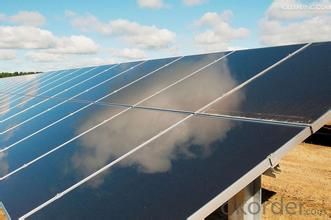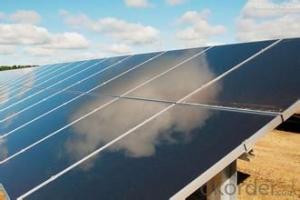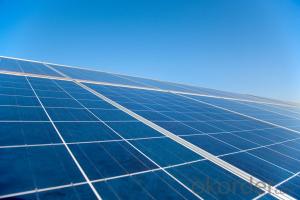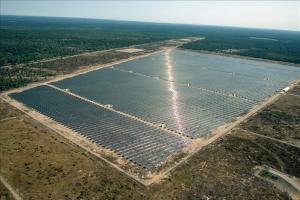250w 260w Monocrystalline Solar Panel Solar Module, TUV Certified
- Loading Port:
- Shanghai
- Payment Terms:
- TT or LC
- Min Order Qty:
- 100 watt
- Supply Capability:
- 111111 watt/month
OKorder Service Pledge
OKorder Financial Service
You Might Also Like
1.Structure of Solar Module Description
Solar panel refers either to a solar hot water panel, a common type of a solar thermal collector, or to one or more solar photovoltaics (PV) modules, electrically connected and mounted on a supporting structure.
A PV module is a packaged, connected assembly of typically 6×10 solar cells. Solar PV panels constitute the solar array of a photovoltaic systemthat generates and supplies solar electricity in commercial and residential applications. Each module is rated by its DC output power under standard test conditions, and typically ranges from 100 to 320 watts. The efficiency of a module determines the area of a module given the same rated output – an 8% efficient 230 watt module will have twice the area of a 16% efficient 230 watt module. There are a few solar panels available that are exceeding 19% efficiency. A single solar module can produce only a limited amount of power; most installations contain multiple modules. A photovoltaic system typically includes a panel or an array of solar modules, an inverter, and sometimes a battery and/or solar tracker and interconnection wiring.
2.Main Features of the Solar Module
1).High conversion efficiencies resulting in superior power output performance.
2).Outstanding power output even in low light or high temperature conditions
3).Optimized design for ease of soldering and lamination
4).Long-term stability,reliability and performance
3.Solar Module Images


4.Solar Module Specification
Specifications
Features:
Aesthetic appearance with excellent efficiency based on innovative
photovoltaic technologies
Strong frame, passing mechanical load test of 5400Pa, instead of the normal
2400Pa,to withstand heavier snow load and higher wind-pressure
Warranties:
10 years limited product warranty
15 years at 90% of the minimal rated power output
25 years at 80% of the minimal rated power output
Specificate sheet:
5.FAQ of Solar Module
1). Q: Are you a factory or trading company?
A: We are a factory.
2). Q: Where is your factory located? How can I visit there?
A: Our factory is located in Jiangyin, Jiangsu, China, near Shanghai. You are warmly welcomed to visit us!
3). Q: How can I get some samples?
A: Please connect me for samples
4). Q: Can the price be cheaper?
A: Of course, you will be offered a good discount for big amount.
- Q:How do solar panels affect the property's resale time?
- Solar panels can significantly impact a property's resale time by reducing energy costs, increasing the property value, and attracting environmentally conscious buyers.
- Q:I am researching several solar panels to install in my house. I would like to use a 40 watt panel to connect, through a solar battery controller, to a battery or two. I would then like to use the solar panel (40 watts) to charge the battery(ies) for emergency use. Once charged, and when needed, I would like to use the battery(ies), 2 volt deep cycle, to power several LED lamps. Since I am new to solar power I had several questions...Is a 40 watt panel strong/large enough to charge a 2 volt deep cycle battery or two?How long would it take to charge one of these batteries?What would be the expected cost to purchase necessary supplies? (With the solar panel, battery controller, and MC4 cabling I've found I have an expected cost of roughly $00.00 with batteries)Would this be difficult for someone with little experience in this field?
- There okorder / Why pay thousands of dollars for solar energy ($27,000 average cost) when you can build your own solar panel system for just a fraction of the retail cost. You can build a single solar panel or you can build an entire array of panels to power your whole house. Some people are saving 50% on their power bill, some people are reducing their bill to nothing. But what’s most impressive is that just by following these instructions some are even making the power company pay them!
- Q:How does the snow cover get removed from the panels?
- Green energy magically makes the snow transparent. The more I learn about solar and wind, particularly selling excess power back to the utility, the less sense it makes. You'll have noticed, perhaps, that there was no way to store the power from the panels for when it's really needed.
- Q:Have a 20V 40W solar panel and it is attach to two backup batteries. Just want to know know how many watt of inverter do I need?
- 500 Watt Solar Panel
- Q:Why can not the solar panel load directly?
- Solar panels because of low power, and the output voltage is extremely unstable, not suitable for load.
- Q:Do solar panels require regular maintenance?
- Yes, solar panels generally require regular maintenance to ensure optimal performance and longevity. This includes periodic cleaning to remove dirt, debris, and snow, as well as checking for any possible damage or malfunctioning components. Additionally, regular inspections and maintenance by professionals are recommended to identify and address any potential issues or inefficiencies.
- Q:I'm writing a post-apocalyptic story in it the main character finds a warehouse. Eventually he finds out the roof is covered with commercial solar panels. Given it's been over a year since the majority of the world died no manainence was done, do they still work?
- they are in a position to be in case you're properly knowledgeable and experienced of their assembly and working function, offered you acquire the comparable severe high quality grade cells and do perfect assembly. probability is robust although that your first a number of could be in hassle-free terms somewhat below par till you rather get the carry of it and strengthen into properly practiced purely because of the fact the pros are. Does take a important volume of grunt paintings although so determine if it rather is great use of a while or in case you will do greater beneficial to earn at your prevalent paintings and pay a professional to do this which they do superb.
- Q:Can solar panels be installed on factories or manufacturing facilities?
- Yes, solar panels can be installed on factories or manufacturing facilities. In fact, many industrial plants have started adopting solar power as a sustainable and cost-effective energy solution. Installing solar panels on rooftops or open spaces of factories allows them to generate clean electricity, reduce their reliance on grid power, and lower their carbon footprint. Additionally, the vast areas available in manufacturing facilities often provide ample space for large-scale solar installations, making them ideal candidates for solar panel installation.
- Q:What do I need to use this as a battery charger
- I hope this will help you choose your charge controller / battery charger more effectively. Good luck!
- Q:I need to power a series of meraki wireless repeaters that plug into a standerd wall outlet. consuming 5v or .08 amps However I need this in a remote location (like out in the middle of nowhere) Using A solar panel as power supply and a battery to store the energy but, how and what do I use to convert the energy coming from the solar panel to the battery and the batteries power supply to match the needs of the meraki wireless repeater? How do I make this as compact as possible? Do I need a ac/dc converter? or dc/ac converter? Any suggestions or solutions would be great !
- First things first. 5 Volts @ .08 amps would be .2 Watts. therefore you would need at least the same amount from a solar panel to replenish the batteries. But what puzzles me is the notion that plugging it in a wall outlet ? If you use 20 V @ 0.08 then the power consumption is 9.6 Watts And what is a meraki wireless repeater? I never heard of one. I'm a FCC licensed Ham and have some idea what is available. If you need 5 volts DC, you could use twelve Ni-cads in series and just keep them trickle charged with the solar panel That would make it compact. If you were to use an automotive battery (or motorcycle), then you would need a DC/DC converter.
1. Manufacturer Overview |
|
|---|---|
| Location | |
| Year Established | |
| Annual Output Value | |
| Main Markets | |
| Company Certifications | |
2. Manufacturer Certificates |
|
|---|---|
| a) Certification Name | |
| Range | |
| Reference | |
| Validity Period | |
3. Manufacturer Capability |
|
|---|---|
| a)Trade Capacity | |
| Nearest Port | |
| Export Percentage | |
| No.of Employees in Trade Department | |
| Language Spoken: | |
| b)Factory Information | |
| Factory Size: | |
| No. of Production Lines | |
| Contract Manufacturing | |
| Product Price Range | |
Send your message to us
250w 260w Monocrystalline Solar Panel Solar Module, TUV Certified
- Loading Port:
- Shanghai
- Payment Terms:
- TT or LC
- Min Order Qty:
- 100 watt
- Supply Capability:
- 111111 watt/month
OKorder Service Pledge
OKorder Financial Service
Similar products
New products
Hot products
Hot Searches
Related keywords






























